Much of the U.K. wine trade gathered last week for the first wine ‘event’ of 2019 – Bourgogne Week. To the Wine Lister team members attending tastings in London, one thing was abundantly clear – the quality across the board is impressive (Wine Lister’s founder, Ella, discussed what a positive surprise the 2017 Burgundy vintage has been in a recent podcast – watch here).
Since there is so much to choose from, and with Burgundy’s popularity continuing to grow (read more in Wine Lister’s Burgundy study here), the Wine Lister team has put together its own list of buys based on tastings attended last week.
The Côte de Nuits has produced many rich examples in 2017. All of Comte Liger-Belair’s wines were stunning, but a particular highlight was his Vosne-Romanée. Both Clos de Vougeots from Faiveley and Jacques Prieur possessed great intensity, while Fourrier’s Gevrey-Chambertin Combe aux Moines was pretty and elegant in style.
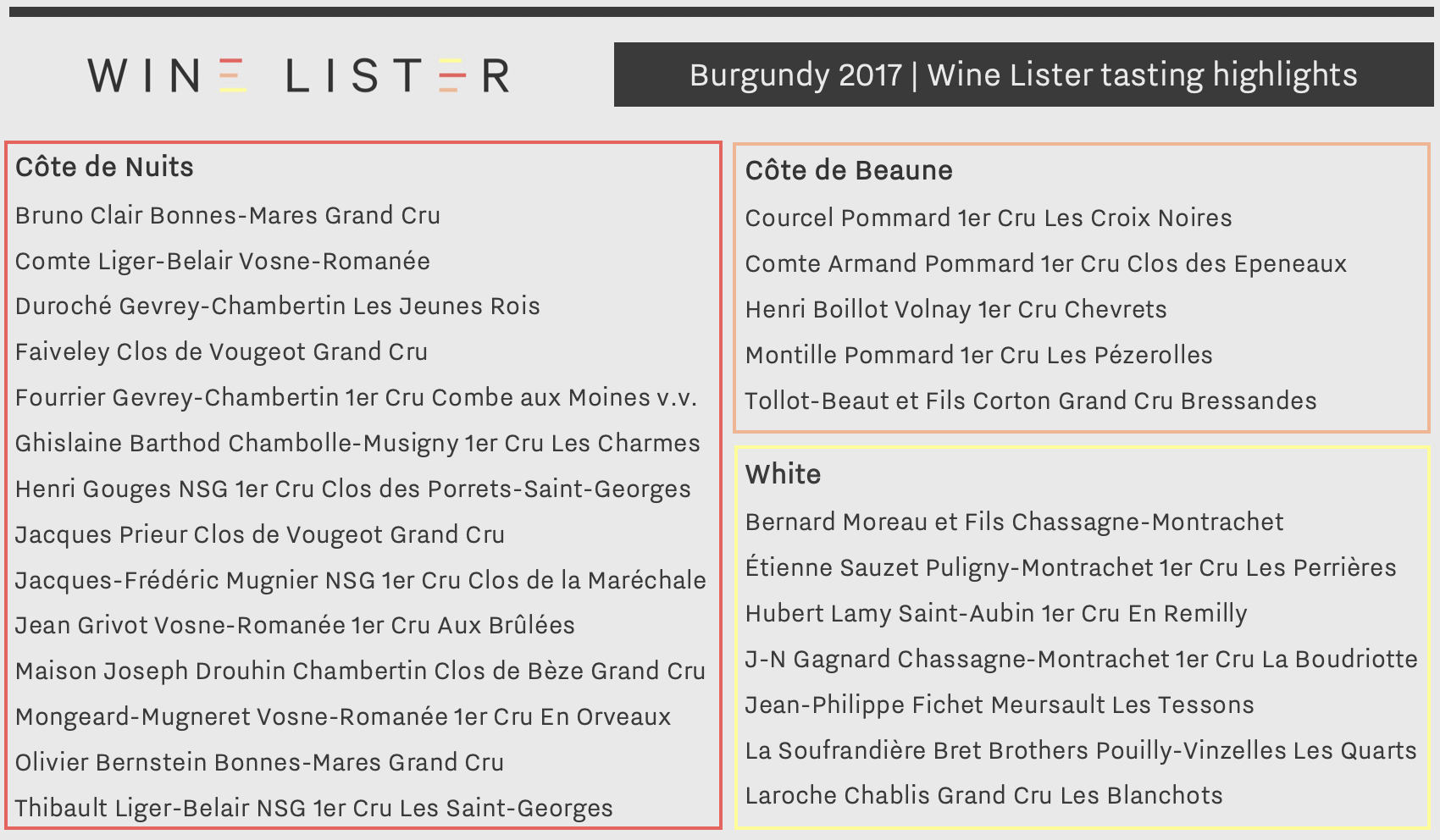
The Côte de Beaune has performed wonderfully in 2017. The team settled on a Volnay, a Corton Bressandes and three Pommards, with two particular favourites – Comte Armand’s Clos des Epeneaux and De Montille’s Les Pézerolles.
Finally, the team were impressed by an array of whites from the Mâconnais right up to the premiers crus from the Côte de Beaune. Hubert Lamy’s Saint-Aubin En Remilly was selected unanimously by Wine Lister team members. Bernard Moreau’s Chassagne-Montrachet impressed, while Bret Brothers’ Pouilly-Vinzelles Les Quarts was a great discovery.
See the rest of the wines included in this post here: Bruno Clair Bonnes-Mares, Duroché Gevrey-Chambertin Les Jeunes Rois, Ghislaine Barthod Chambolle-Musigny Les Charmes, Henri Gouges Nuits-Saint-Georges Clos des Porrets-Saint-Georges, Jacques-Frédéric Mugnier Nuits-Saint-Georges Clos de la Maréchale, Jean Grivot Vosne-Romanée Aux Brûlées, Maison Joseph Drouhin Chambertin Clos de Bèze, Mongeard-Mugneret Vosne-Romanée En Orveaux, Olivier Bernstein Bonnes-Mares, Thibault Liger-Belair Nuits-Saint-Georges Les Saint-Georges, Courcel Pommard Les Croix Noires, Henri Boillot Volnay Chevrets, Tollot-Beaut Corton Bressandes, Étienne Sauzet Puligny-Montrachet Les Perrières, Jean-Noël Gagnard Chassagne-Montrachet La Boudriotte, Jean-Philippe Fichet Meursault Les Tessons, Laroche Chablis Les Blanchots.
As July begins, much of the wine world may feel more grey and drizzly than the weather would suggest, due to a case of post-primeurs blues. Indeed, Wine Lister’s founder, Ella Lister, reports in her recent article for JancisRobinson.com that “…the majority of merchants are reporting revenues down approximately two-thirds on 2016”. In that article, a comparison of Quality scores across recent vintages highlights the value proposition of the 2014 vintage. In this blog post we dig a bit deeper.
A few weeks into this year’s en primeur campaign releases, the Wine Lister team noticed a distinct pattern. With almost every new release, we sounded more and more like broken records, echoing that château X’s 2017 release price, while below the last two vintages, made the 2014 look like good value. While it has been pigeonholed as a good but not great vintage, 2014 achieved consistently high critics’ scores that imply its reputation should be better.
The chart below shows Bordeaux 2014 and 2017 average Quality scores by appellation, comparing 2014 three-month average prices with 2017 release prices.
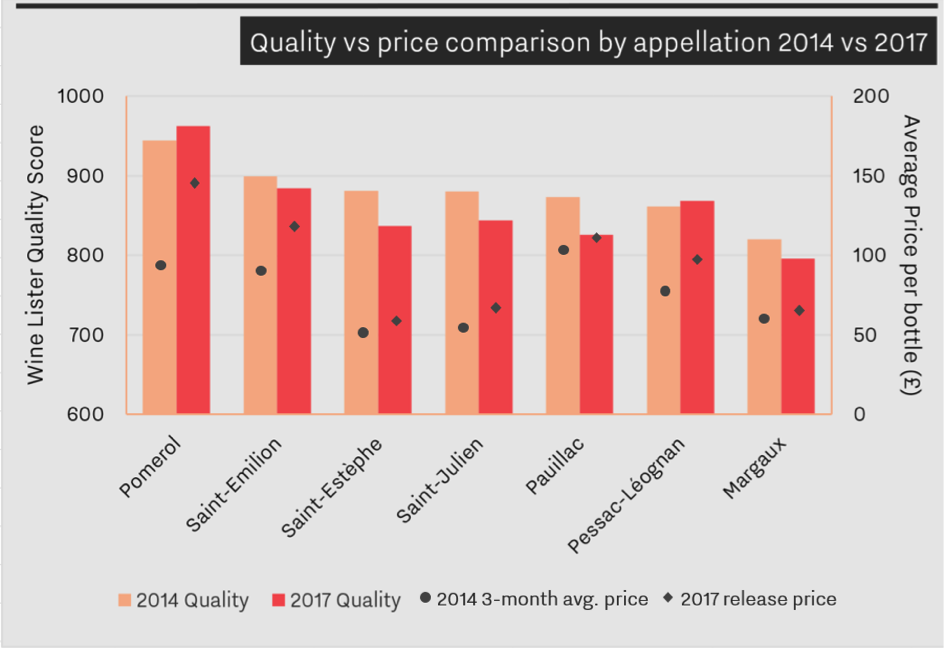
Based on 75 key Bordeaux classified growths, the chart illustrates the relationship between quality and price (note the price gap for 2014 and 2017 Saint-Émilion, despite similar average Quality scores). Only Pomerol and Pessac-Léognan achieved higher Quality scores on average in 2017 than in 2014, with Wine Lister’s partner critics preferring 2014 across all other appellations.
While the trade puts aside its allocations of 2017 for the time being, perhaps the silver lining is the light this vintage shines on relative value elsewhere. Is it time for merchants and collectors alike to focus on 2014?

We used Wine Lister’s comparison tool in our search for good-value back vintages in order to compare different vintages and their respective critics’ scores and prices. For example, Malescot Saint-Exupéry achieves a Quality score of 894 in 2014, versus 735 in 2017. Despite the substantial price reduction on the 2016 and 2015 vintages, the 2017 UK market price remains 5% higher than the 2014, the latter receiving higher scores from three of the four Wine Lister partner critics. Neal Martin disagrees, awarding the 2017 a potential 2 points more than 2014 saying, “it is not a complex Malescot St. Exupéry, but I admire the balance and focus”.
Malescot Saint-Exupéry 2014 has the highest Value Pick score of any recent vintage:
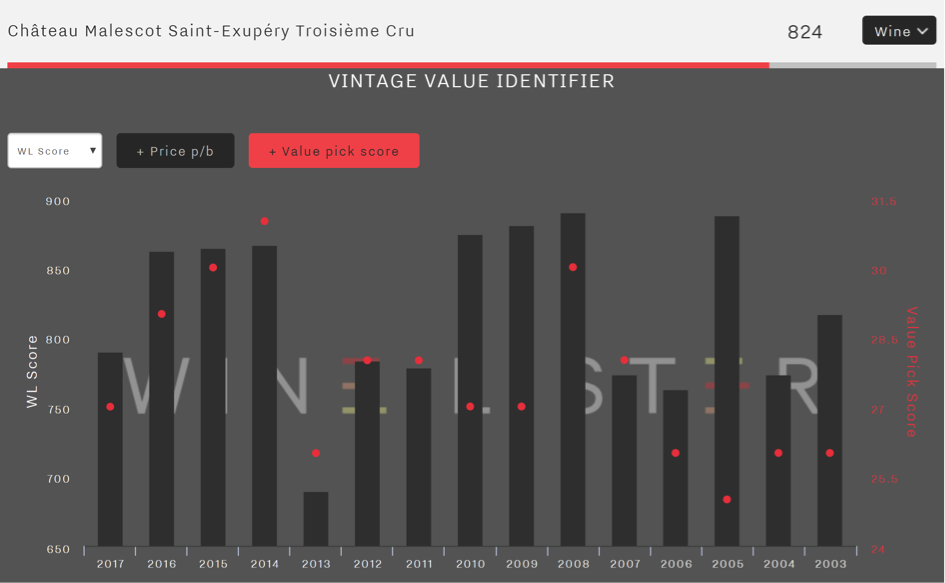
Use the Vintage Value Identifier chart (pictured above) on every wine page to pick out the best value back vintages. For example, Cantenac-Brown’s 2014 looks like a particularly good buy, at £25.50 per bottle for the 2014 (whose Quality score is 800), versus the 2017 at £34.05 per bottle, with a Quality score of 715. Its 2015 looks good too.
With daily en primeur release alerts and offers for the new 2017 vintage filling our inboxes, the “Bordeaux buzz” at this time of year is undeniable. However, Bordeaux’s popularity does not end with en primeur, as we prove with results of the last quarter’s trading volumes.
Wine Lister uses figures collated by the Wine Market Journal from sales at the world’s major auction houses to calculate incremental increases in four-quarter trading volumes – in this case, January-December 2017 versus April 2017-March 2018. Auction volumes contribute towards Wine Lister Economics scores, allowing us to measure the liquidity of each wine.
The five wines showing the biggest increases in trading volumes between these two periods all hail from Bordeaux. Indeed, such is the case for the top 20 auction volume increases, with the exception of brand royalty, Dom Perignon (in 10th place).
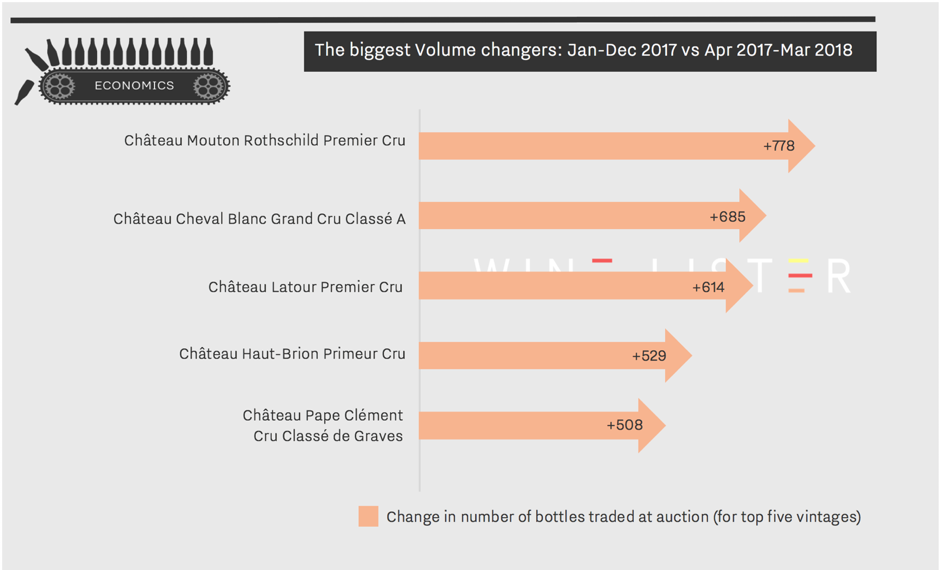
The wine experiencing the biggest increase in trading volumes is Mouton Rothschild, with 778 additional bottles traded. It has the highest Economics score of the five (956) and a compound annual growth rate (CAGR) of 11.3%. Kicking off the first growth releases of 2017 vintages this week, Mouton Rothschild’s 2017 UK release price sits 17% below last year’s at £360 per bottle.
In second place is right bank powerhouse, Cheval Blanc, whose trading volume increased by 685 bottles with the addition of the most recent quarter’s figures. Though second for incremental change, its total trading volume is at least 30% smaller than any of the left bank first growths.
Latour and Haut-Brion come in third and fourth place, both with 12% trading increases of 614 and 529 respectively.
Finally, trades of Pape Clément keep the Pessac-Léognan property’s red in the top five for trade increases for a consecutive quarter, with 506 more bottles traded in the current period. Despite dropping four places since last quarter’s auction volume results, Pape Clément still achieves the highest proportional change of all five wines at the top, with a 27% trading volume increase.
Angélus 2017 released at €276 ex-négociant (6% down on 2016), with a UK release price of £280 (6% down on 2016), with a lower Quality score: 938 (vs 965).
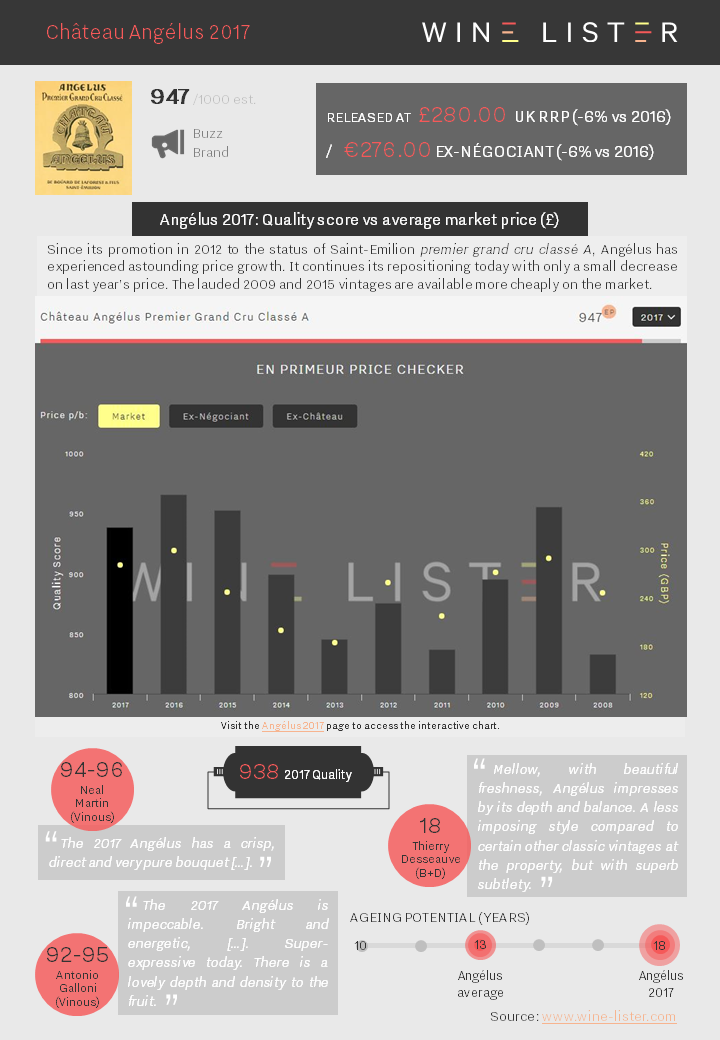
You can download the slide here: Wine Lister Factsheet Angélus 2017
Margaux 2017 released at €348 ex-négociant (17% down on 2016), with a UK release price of £360 (17% down on 2016), with a lower Quality score: 938 (vs 982).
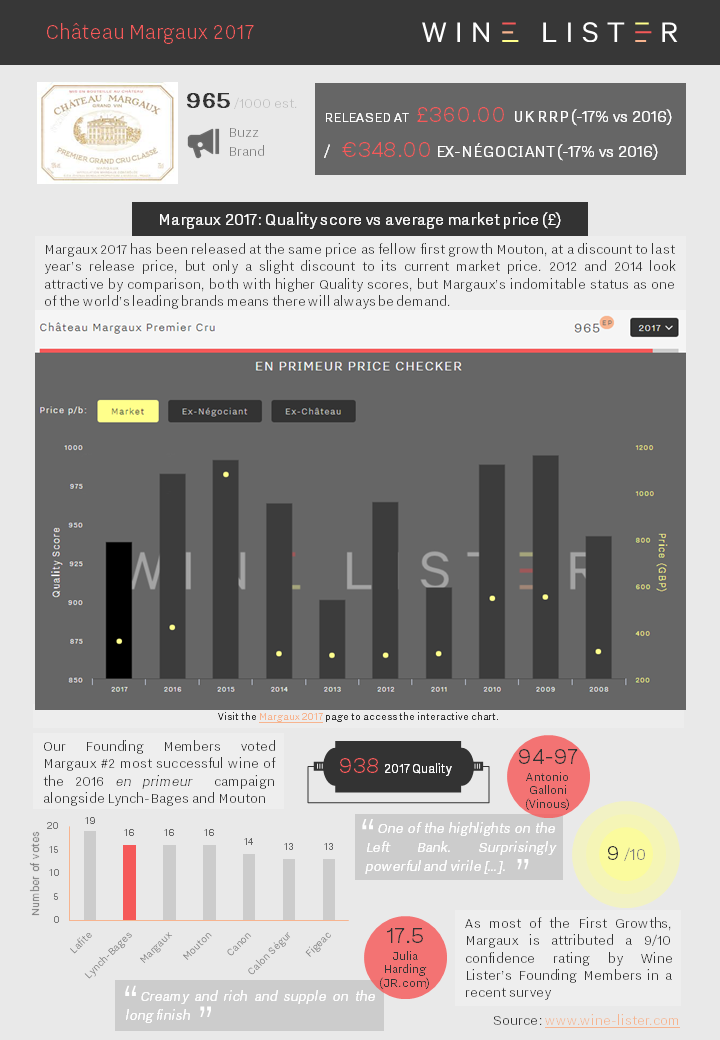
You can download the slide here: Wine Lister Factsheet Margaux 2017
La Conseillante 2017 released at €120 ex-négociant (20% down on 2016), with a UK release price of £123 (22% down on 2016), with a slightly lower Quality score: 954 (vs 971).
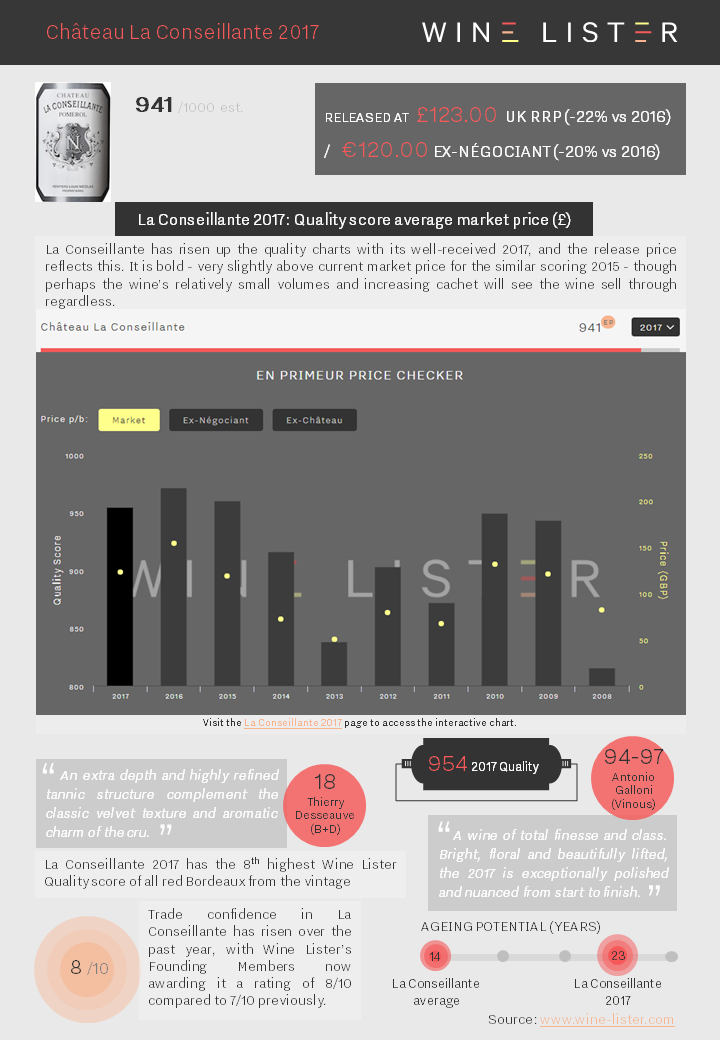
You can download the slide here: Wine Lister Factsheet La Conseillante 2017
Pontet-Canet 2017 released at €80 ex-négociant (26% down on 2016), which will likely result in a UK release price of c.£82 (28% down on 2016), with a lower Quality score: 911 (vs 981).
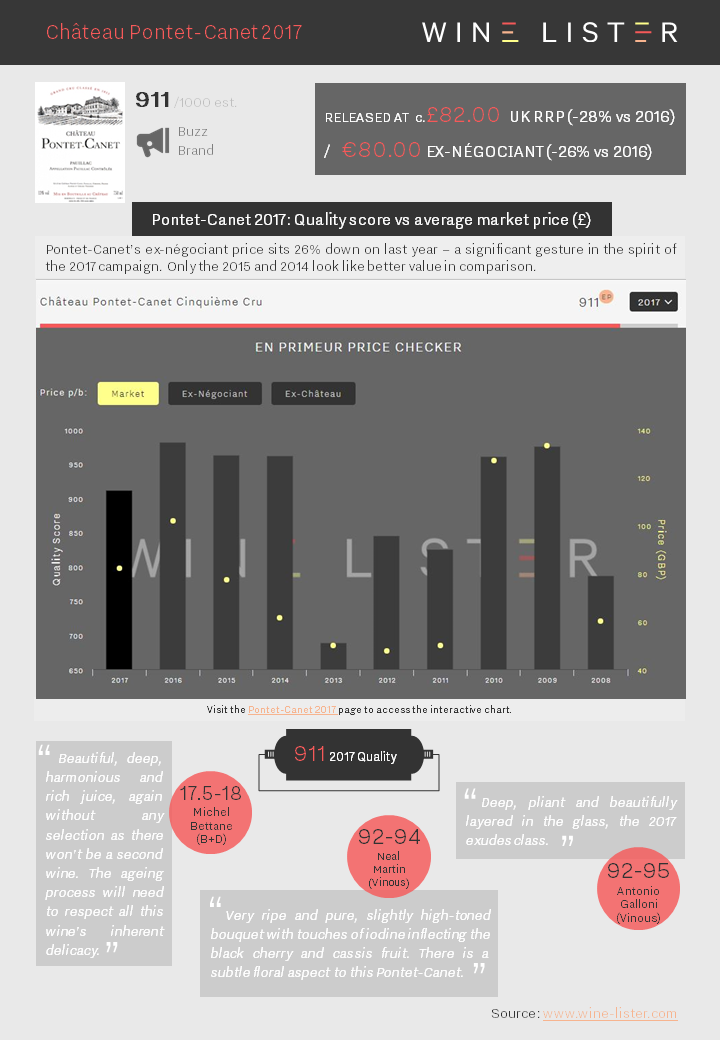
You can download the slide here: Wine Lister Factsheet Pontet-Canet 2017
Haut-Bailly 2017 released at €72 ex-négociant (14% down on 2016), with a UK release price of £74 (11% down on 2016), and a lower Quality score: 921 (vs 964).
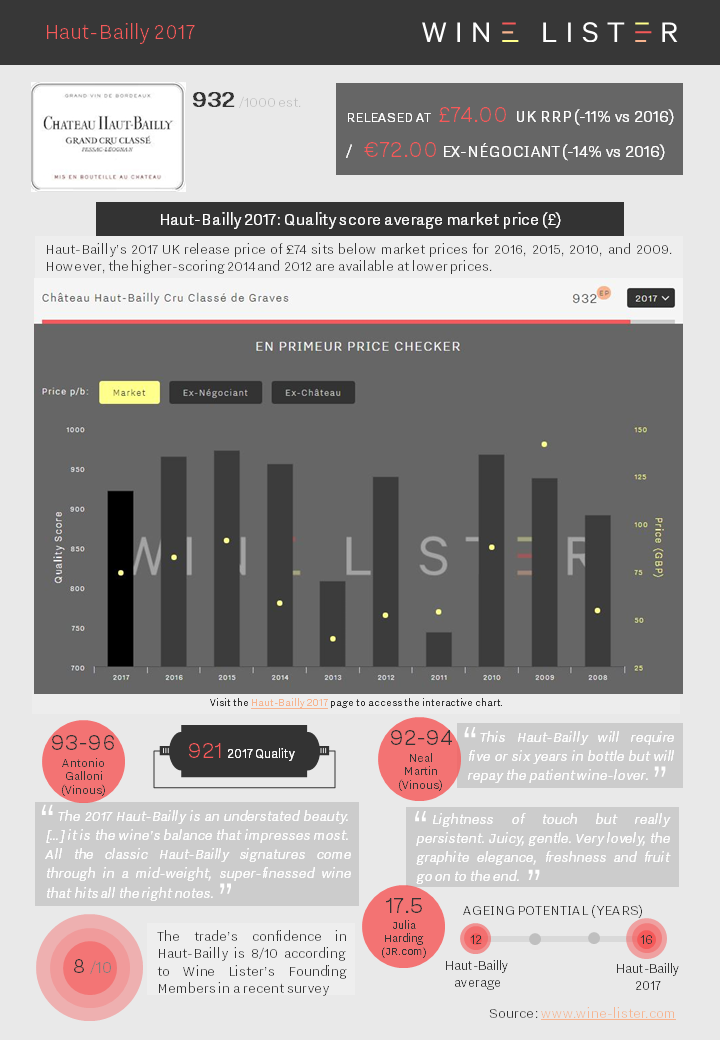
You can download the slide here: Wine Lister Factsheet Haut-Bailly 2017
Mouton Rothschild 2017 released at €348 ex-négociant (17% down on 2016), with a UK release price of £360 (also 17% down on 2016), and a lower Quality score: 953 (vs 991).
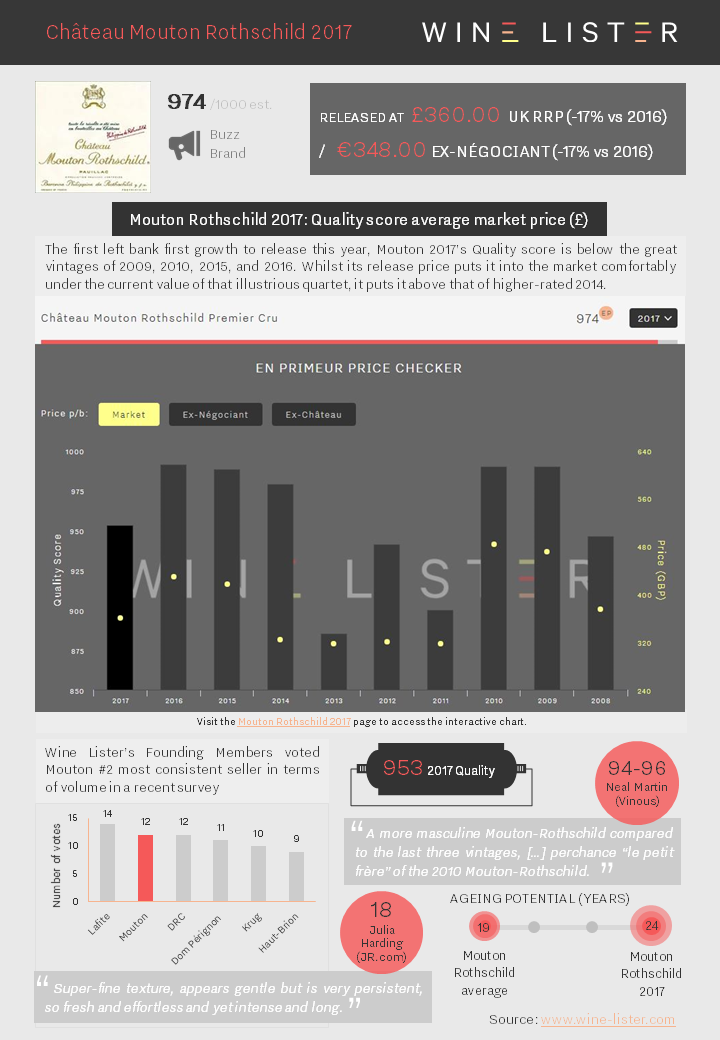
You can download the slide here: Wine Lister Factsheet Mouton Rothschild 2017
Léoville Poyferré 2017 released at €54.00 ex-négociant (18% down on 2016), with a UK release price of £55.50 (17% down on 2016), and a lower Quality score: 910 (vs 966).
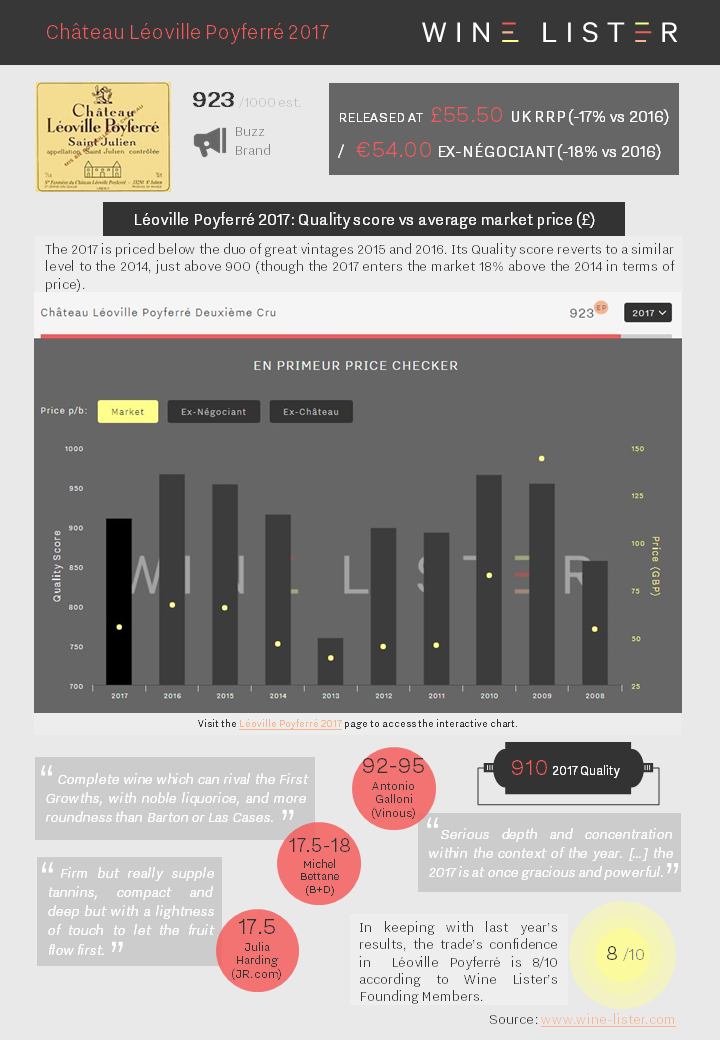
You can download the slide here: Wine Lister Factsheet Léoville Poyferré 2017











